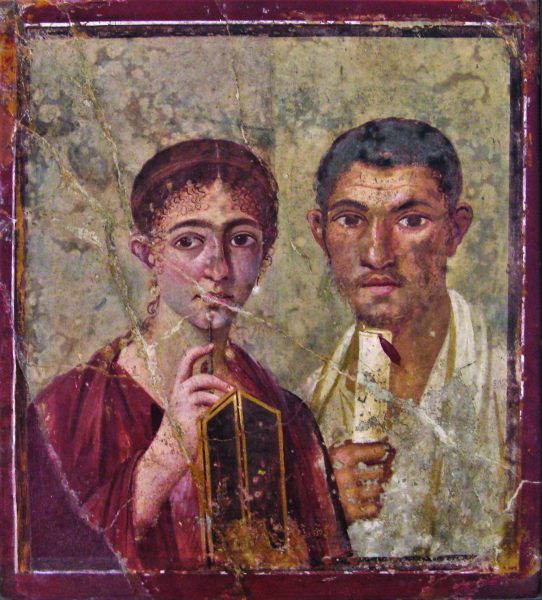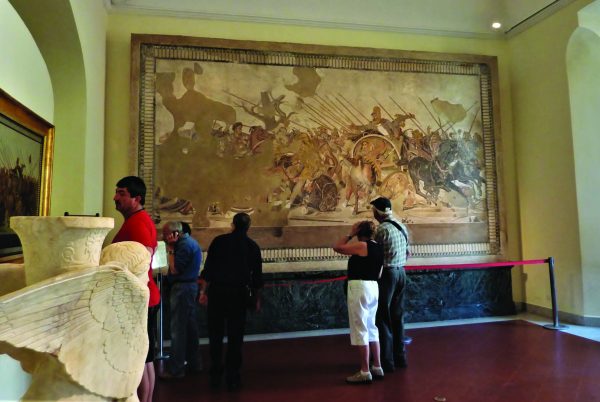Discover how the finest treasures of Pompeii found their way to Naples with Joe Gartman
Images by Patricia Gartman

Let’s say you’re a well-connected citizen of Pompeii back in about 80 BC (don’t worry, it’s another century-and-a-half before Vesuvius is set to blow) and you’re invited to dinner at the most luxurious house in town.
You arrive at the southern entrance, where a slave meets you and conducts you into a spacious atrium, open to the sky. You can’t help noticing the statuette of a dancing faun in the impluvium (a large marble basin for collecting rainwater). Here the hosts welcome you, and, chatting of this and that, you follow them across a columned inner peristyle, or courtyard, where a small fountain plays, surrounded by ornamental shrubs and statuary.
Opening off the courtyard is a smallish area – an exedra – where three frescoed walls frame a brilliantly coloured pavement mosaic. It depicts Alexander the Great driving a frightened Darius of Persia from the battlefield, and is composed of tiny, expensive opus vermiculatum tesserae rather than the more common opus tesselatum made with larger, uniformly square stones.
Through a doorway to your left, you see other guests already in the dining room, reclining on cushioned couches, nibbling on stuffed dormouse hors d’oeuvres. As you join them, a servant hands you a silver cup of fine Falernian wine, cut with seawater – just the way you like it. It looks like it’s going to be a great evening! (Perhaps we’d better return to the 21st century before we find out what else is on the menu at the House of the Faun.)
If you like, though, you can visit Pompeii and stroll through the premises; the dancing faun and the Alexander mosaic will be there – but they’re copies. To see the real things, you’ll have to go to Naples, to the National Archaeological Museum. In fact, thousands of objects from Pompeii, Herculaneum, and Stabiae, all buried by the eruption of Vesuvius in 79 AD, can be found in the museum. It’s a very pleasant way for us to admire the stunning artwork of that remote but strangely familiar time. But how did all those bits of history, buried for 1,600 years, fetch up in Naples?
We’d probably better begin back in 1709. By that time, new farms, vineyards, and even towns had taken root in the volcanic soil above the long-forgotten cities. The village of Resina, for example, sat almost exactly above Herculaneum; and one day, a well-digger unearthed some interesting fragments of worked marble. He showed them to the Prince d’Elbeuf, an Austrian nobleman who was building a villa in nearby Portici; the prince immediately hired workmen to dig the well deeper, and they bottomed out in Herculaneum’s main theatre. Tunnelling sideways for the prince, they spent the next six years ploughing through the buried city, collecting ancient statuary and art to decorate his palace. But business called the prince back to Austria, and explorations stopped – temporarily.
In 1732, a very confusing war – the War of the Polish Succession – broke out. Many of the crowned heads of Europe took the opportunity to play military musical chairs, and when the music stopped, Charles of Bourbon, Duke of Parma, found himself sitting (figuratively) on two thrones – as King of Naples and as King of Sicily. Austria had to settle for Parma. He moved to Naples, and after seeing d’Elbeuf’s villa in Portici, decided to build one there for himself, and decorate it with the marvellous treasures that seemed to grow out of the local soil.

In 1738, Charles of Bourbon hired a Spanish military engineer, Joaquín de Alcubierre, to excavate the area. Alcubierre found plenty of treasures, certainly, at the cost of smashed walls, crumbled frescoes, and broken pottery. Later on, around 1750, he was replaced by Karl Weber from Switzerland whose methods were a bit more restrained. By this time, excavation had spread to the area of Pompeii, an even richer source of marvellous finds. Everything of interest that could be moved became part of the king’s fast-growing collection, housed in his new villa. The villa in Portici became, almost by necessity, a museum – Il Museo Herculanense – stuffed with wonders. Many famous travellers on the Grand Tour, including J.J. Winckelmann and Johann Wolfgang von Goethe, found it a highlight of their travels. But everything was still the private property of the king; his permission was required to visit, and making drawings of the objects was strictly forbidden. As an aside, Charles certainly possessed an excess of artistic riches: in addition to the antiquities in Portici, his mother, Elisabetta Farnese, had willed him the Farnese sculpture collection – you know, the Farnese bull, Hercules, Venus Kallipygos, etc – which he kept safely in the Capodimonte Palace in Naples.)
When Charles inherited the Spanish throne from his half-brother in 1759, he abdicated the thrones of Naples and Sicily to his son Ferdinand IV. It was Ferdinand who conceived the idea of consolidating all the king’s antiquities, from both the Museo Herculanense and the Capodimonte, in one museum, the Real (‘Royal’) Museo Borbonico. The museum, housed in a 16th-century, neo-classical former cavalry barracks, opened – to the public – in 1777. But both collections were not fully installed until 1822, because of political instability, including the fact that when Napoleon conquered Naples in 1806, Ferdinand fled to Sicily, taking as many antiquities with him as he could carry, and didn’t return until 1816.
Since 1843, the Alexander mosaic has been mounted on a wall in the museum, with the dancing faun nearby. The Real Museo Borbonico was renamed the Museo Archeologico Nazionale di Napoli in 1861, after Naples fell to Garibaldi, and the contents now belong to the Italian people. Let us raise a glass of fine Falernian wine in celebration – but hold the seawater!
Enjoyed this article? Check out more articles by Joe Gartman in our archive today!
